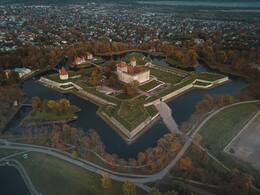Legend of the walled-in knight
According to legend, in 1785, a Russian engineer who had drawn up a plan for a convent building found a basement in the eastern corner of the courtyard of the fortress.
Legend has it that a Russian engineer, who in 1785 drafted the plans for a convent building on the site, found a walled-up cellar in the eastern corner of the inner courtyard.
In the middle of the cellar stood a massive table, with a skeleton sitting at it in a leather armchair. The skeleton was wearing fine clothing, which had seemingly turned from brown to violet over the years, and riding boots with spurs. A red velvet hat with a white peacock feather was hung on the wall, a lamp mounted beside it on an iron console. In front of the skeleton, on the table, was a clay mug, a pile of illegible mouldered papers and bread crumbs, while inside the table drawer was a set of black glass rosary beads. At the slightest touch the skeleton crumbled to the floor, but the drawing teacher from the town school managed to make sketches of the knight before this occurred.
These were the remains of a knight who had been walled in alive in the cellar by order of the bishop during the Reformation. As the Catholic Bishop of Ösel-Wiek tended to get overwhelmed by his Protestant subjects, he turned to the Pope in Rome for help. The pope sent him a Spanish inquisitor to bring order among the vassals. His piety and determination were put to the test by the vassals, who presented him with a fair-haired maiden. The knight fell in love with the girl, which violated the requirement of celibacy in the Catholic Church. The affair soon became public, and the girl's head was shaved before she was sent to repent at a nunnery in Kaarma. The Spaniard was at first let off with a warning. However, the infatuated inquisitor decided to free the girl from the convent. Unfortunately, a letter he had written and hidden inside a piece of bread, instead of reaching his love, ended up on the desk of the bishop. It was then decided that this servant of God had gone astray and could not find salvation, for which he was walled in alive in the castle cellar in Kuressaare. Since this revelation, the cellar has been referred to as the Cellar of the Walled-in Knight.
Saaremaa Museum
Related objects
Saaremaa Museum
Kuressaare Castle is situated on the southern edge of the Kuressaare town, by the sea.
The anniversary of Saaremaa Museum, which is housed in the fortress, is celebrated on 17 February: the date in 1865 when the Society for Research of Saaremaa (Verain zur Kunde Oesels) was founded. The museum relocated to the castle in 1897. Its exhibition showcases the nature and history of Saaremaa. The largest and most noteworthy exhibit at the museum is the castle itself, which a fine example of the development of military fortifications between the 14th and the 19th centuries. Kuressaare Castle is one of the most authentic fortifications anywhere in Northern Europe.









